SERC-West Summer Intern Spotlights
by Ryan Greene, science writing intern
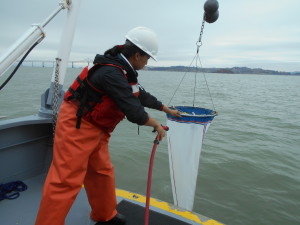
Intern Elena Huynh helps clean a net during SERC’s annual zooplankton survey in San Francisco Bay. Credit: Ryan Greene/SERC
The Smithsonian Environmental Research Center’s (SERC) main campus is on the Chesapeake Bay in Maryland. SERC’s largest West Coast outpost, SERC-West, sits on the San Francisco Bay in California. To highlight SERC’s work out west, we’ve started “Tidings from the Sunset Coast,” a summer series about the life and times of SERC-West. Our first post explored California’s wet winter. This post features the stellar interns who are spending their summer at SERC-West.
Interns at the Smithsonian Environmental Research Center have the chance to work on independent projects while receiving personalized mentorship in a multidisciplinary atmosphere. Some people conduct experiments, others develop educational programs, and others (like me) write about the happenings at SERC. Simply put, SERC internships let you grow in whatever ways you want to be growing!
Check out the spotlights below to see what the interns at SERC-West are up to this summer.
***
ELENA HUYNH: Setting up biological duels
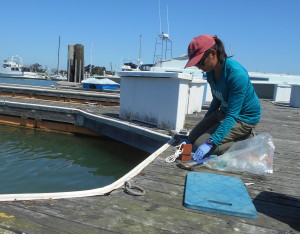
Elena Huynh prepares to deploy a settlement panel which will help her study the fouling community. Credit: Ryan Greene/SERC
Elena Huynh was born and raised in San Francisco, and for the last year and a half, she’s been an intern at SERC-West. Back in college at the University of California, Davis, Huynh studied animal biology with a focus on marine ecology. After graduating in 2015, she worked as a manager at Walgreens for a bit, and then started helping out with fieldwork at SERC-West. This summer, she’s working on her first big solo project at the lab, where she’s keeping a close eye on the animals that coat rocks, docks, and boat hulls—a.k.a. the fouling community.
Huynh’s project is inspired by two facts: First, San Francisco had an incredibly wet winter this year. Second, no single species is great at everything. In a nutshell, all the fresh water from the winter rains killed off many members of the fouling community. Now Huynh’s watching to see how invertebrates in the Bay recover. She’s expecting that the first organisms to show up will be pretty tolerant to fresh water. Later, once the Bay’s salinity starts to return to normal, she thinks other organisms will take control who are better competitors but prefer saltier waters, and so were originally shut out by the freshwater influx. To test her hypothesis, she’s setting up experimental “duels” on plastic panels to see which organisms are better at claiming space. Additionally, she’s checking their salinity tolerances to see who can survive freshwater conditions. All together, her experiment is helping her suss out how particular combinations of traits are shaping the trajectory of recovery in the Bay.
***
JAMIE BUCHOLZ: Boxing out predators
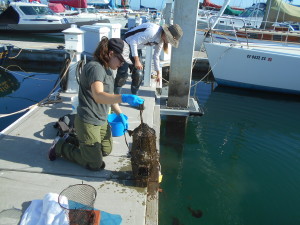
Jamie Bucholz (front) pulls up one of her experimental cages in San Francisco Marina with help from SERC researcher Gail Ashton. Credit: Ryan Greene/SERC
Jamie Bucholz grew up in Maiden Rock, Wisconsin, on the Mississippi River. Though she entered college as an English major at the University of Wisconsin-River Falls, her academic life switched course after she took an intro biology class. “In high school I was not allowed to learn about evolution,” she says. “So when I went to college, it was my first experience…being taught the basic principles behind evolution, and I just fell in love with biology in that class.” Over the next four years she started working in an invertebrate ecology lab, and since then she’s been hooked.
This summer, Bucholz is spending her internship at SERC-West studying what happens when you stop predators from feeding on fouling organisms. She’s hoping this will shed light on how animals that eat these organisms impact the makeup of the fouling community. Do they tend to limit the amount of invasive species? Do different types of organisms show up if the predators are absent? Do the same patterns hold true in different ecosystems? To test all this, she’s built an intricate system of suspended cages in San Francisco Marina that keep fish and other predators out. She’s also sent similar cages to sites in Panama and Alaska so that she can compare results at different latitudes. After finishing this project, she’s heading to Central Michigan University to embark on a master’s program in biology, where she’ll be studying the endangered freshwater hickorynut mussel.
***
ANA SOFIA REMIS: Putting clams to the test
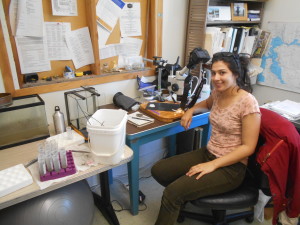
Ana Sofia Remis gets ready to weigh and photograph some of her experimental clams. Credit: Ryan Greene/SERC
Originally from Miami, Florida, Ana Sofia Remis is a dual environmental studies/design & technology student at the New School in New York City. In the past, she’s worked for a couple science-related nonprofits, but until this summer, she hadn’t had the chance to get her hands dirty in the field. Now, she’s finally getting to “work in the mud and see the animals…and work with them directly.” Specifically, she’s spending her summer conducting an experiment with Gemma gemma, an invasive clam from the Atlantic coast.
Given the extremely wet winter San Francisco experienced this year, and the subsequent inundation of freshwater into the Bay, Remis wants to put Gemma gemma to the test to figure out how well it can survive in less salty water. To do this, she’s designed an experimental setup that exposes the clams to water of different salinities over the course of several weeks. Though she admits these small mollusks aren’t necessarily the most charismatic, she enjoys their company and imagines they’d like to snuggle if they could.
***
RYAN GREENE: Translating marine science
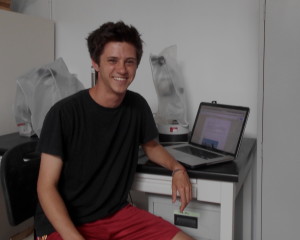
Ryan Greene drafts a version of this blog post in the lab at SERC-West. Credit: Elena Huynh/SERC
As for me, I’m a desert kid from Phoenix, Arizona. This past December I graduated from Brown University, where I studied biology and creative writing. Since April I’ve been working as a bi-coastal science writing intern at SERC. For the first couple months, I was stationed at the main campus in Maryland, and now I’m at SERC-West in California. During this time, I’ve tagged along with scientists in the field, snapped photos, and written up snippets about SERC’s wide-ranging research.
I think about science writing as a form of translation—not a way to dumb things down, but rather a way to reach out to new audiences. To this end, I’ve created SERC-related media that people can read, hear, look at, and even touch. Going forward, I hope to continue working on multimedia approaches to science communication while beginning to develop bilingual resources for SERC’s native oyster restoration project here in San Francisco Bay.
***
If you’re interested in learning more about internships at SERC, check out the internships page on our website. For information on internship opportunities at the Smithsonian more broadly, visit the Smithsonian’s Office of Fellowships and Internships.

